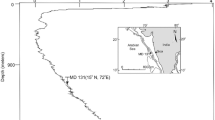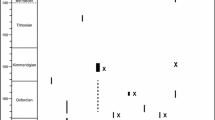Abstract
A Holocene ecological succession was documented using palynological, foraminiferal, and molluscan faunas sampled from an excavated trench on the margin of Bell River Bay, Lake Winnipegosis, Manitoba. The palynological data record the known gradually isostatically-induced shift from aquatic to terrestrial conditions at the site, and clearly delineates the Holocene Hypsithermal maximal warm interval (commencing here about 5500 years BP). Concurrent with this warming the site became occupied by the extinct salt tolerant gastropod Marstonia gelida and the marine foraminifer Cribroelphidium gunteri by at least 5430 years BP. Water fowl-assisted colonization of non-marine habitats by foraminifera has previously been suggested as a dispersal mechanism for other non-marine foraminiferal occurrences. However, as this relatively warm-water foraminifer (presently found as far north as Cape Cod, MA on the Atlantic USA coast, and Vancouver, BC on the Canadian Pacific coast but also found in Canadian Maritime provinces during the Hypsithermal) did not inhabit the area either prior to or following the Hypsithermal warm interval, this occurrence indicates the efficiency with which foraminifera can utilize non-selective avian transport to colonize new non-marine and marine habitats. It may be that only a few years were required for colonization of the site to occur (2000–3000 km distant from native populations); this suggests that avian transport is a much more important foraminiferal dispersal mechanism than previously realized. The appearance of foraminifera at this site may also constrain models designed to determine the time required for hydraulically injected glacial freshwater to be flushed from normally brine producing aquifers in the region.
Similar content being viewed by others
References
Baker, F. C., 1921. New forms of Pleistocene mollusks from Illinois. Nautilus 35: 22–24.
Baker, F. C., 1926. Nomenclatorical notes on freshwater Mollusca. Transactions of the Wisconsin Academy of Sciences, Arts and Letters 22: 193–205.
Barnes, D. W., 1823. On the genera Unio and Alasmodonta, with introductory remarks. Am. J. Sci. 6: 269.
Brady, G. S. & D. Robertson, 1870. The ostracoda and foraminifera of tidal rivers with an analysis and description of the foraminifera. Ann. Mag. nat. Hist. 6: 273–309.
Bryson, R. A., 1987. On climates of the Holocene. In N. A. McKinnon & G. S. L. Stuart (eds), Man and the Mid-Holocene Climate Optimum. Proceeding of the 17th Annual Archaeological Conference, Calgary, Alberta, Canada, 1–13.
Downey, J. S., 1984. Geohydrology of the Madison and associated aquifers in parts of Montana, North Dakota, South Dakota and Wyoming, US. Geological Survey Professional Paper 1273-G: 47 pp.
Faegri, K. & J. Iverson, 1975. Textbook of Pollen Analysis. Third Edition. Munksgaard, Copenhagen, 275 pp.
Fishbein, E. & R. T. Patterson, 1993. Error-weighed maximum likelihood (EWML): a new statistically based method to cluster quantitative micropaleontological data. J. Paleontol. 67: 475–485.
Gould, A. A., 1841. A report on the Invertebrata of Massachusetts. Cambridge, Massachusetts, 373 pp.
Hanson, H. C. & R. H. Smith, 1950. Canada geese of the Mississippi flyway: with special reference to an Illinois flock. Bull. Illinois Nat. Hist. Surv. 25: 210 pp.
Jonasson, K. & R. T. Patterson, 1992. Preservation potential of marsh benthic foraminifera from the Fraser River Delta, British Columbia. Micropaleontology. 38: 289–301.
Klassen, R. W., 1983. Lake Agassiz and the late glacial history of northern Manitoba. In J. T. Teller & L. Clayton, L. (eds), Glacial Lake Agassiz, Geological Association of Canada Special Paper 26: 97–115.
Kroker, S., 1983. Palynological investigations of Waldsea Lake central Saskatchewan. Unpublished report on file with Department of Geology, University of Manitoba, 10 pp.
Kroker, S., 1984. Palynological analysis of Deadmoose and Lenore Lakes, Saskatchewan. Unpublished report on file with Department of Geology, University of Manitoba, 8 pp.
Linnaeus, C., 1758. Systema naturae per regna tria naturae. 10th ed. Holmiae, Laurentii Salvii, 824 pp.
McKillop, W. B., R. T. Patterson, L. D. Delorme & T. Nogrady, 1992. The origin, physico-chemistry and biotics of sodium chloride dominated saline waters on the western shore of Lake Winnepegosis, Manitoba. Can. Field-Nat., 106: 454–473.
Mosteller, F., R. E. K. Rourke & G. B. Thomas, Jr., 1970. Probability and Statistical Applications. Addison-Wesley Publishing Company, Don Mills, Ontario, 527 pp.
Mott, R. J., 1973. Palynological studies in central Saskatchewan from lake sediment sequences. Geological Survey of Canada, Paper 72–49.
Nichols, H., 1969. The late Quaternary history of vegetation and climate at Porcupine Mountain and Clearwater Bog, Manitoba. Arctic and Alpine Research 1: 155–167.
Nielsen, E., D. H. McNeil & W. B. McKillop, 1987. Origin and paleoecology of post-Lake Agassiz raised beaches in Manitoba. Can. J. Earth Sci. 24: 1478–1485.
Patterson, R. T., 1987. Arcellaceans and foraminifera from Lake Tecopa, an eastern California Pleistocene Lake. J. Foramin. Res. 17: 333–343.
Patterson, R. T. & E. Fishbein, 1989. Re-examination of the statistical methods used to determine the number of point counts needed for micropaleontological quantitative research. J. Paleontol. 63: 245–248.
Patterson, R. T., 1990. Intertidal benthic foraminiferal biofacies on the Fraser River Delta, British Columbia: modern distribution and paleoecological importance. Micropaleontology 36: 183–199.
Patterson, R. T. & W. B. McKillop, 1991. Distribution and possible paleoecological significance of Annectina viriosa, a new species of agglutinated foraminifera from non-marine salt ponds in Manitoba. J. Paleontol. 65: 33–37.
Patterson, R. T., K. D. MacKinnon, D. B. Scott & F. S. Medioli, 1985. Arcellaceans (Thecamoebians) in small lakes of New Brunswick and Nova Scotia: modern distribution and Holocene stratigraphic changes. J. Foramin. Res. 15: 114–137.
Patterson, R. T., D. B. Scott & W. B. McKillop, 1990. Recent Marsh-Type Agglutinated Foraminifera From Lake Winnipegosis, Manitoba. In C. Hemleben, M. A. Kaminski, W. Kuhnt & D. B. Scott (eds), Proceedings of the third International Advanced Course on Paleoecology, Biostratigraphy, Paleoceanography, and Taxonomy of Agglutinated Foraminifera. NATO Advanced Study Institutes Programme, Series C: Mathematical and Physical Sciences 327: 765–781.
Phleger, F. B., 1965. Patterns of marsh foraminifera, Galveston Bay, Texas. Limnol. Oceanogr. 10: R169-R184.
Phleger, F. B., 1966. Patterns of living marsh foraminifera in south Texas coastal lagoons. Boletin de la Sociedad Geológica Mexicana 28: 1–44.
Phleger, F. B., 1970. Foraminiferal populations and marine marsh processes. Limnol. Oceanogr. 15: 522–534.
Poag, C. W., 1978. Paired foraminiferal ecophenotypes in Gulf Coast estuaries: ecological and paleoecological implications. Gulf Coast Association of Geological Societies. Transactions. 28: 395–421.
Ritchie, J. C., 1964. Contributions to the Holocene palaeoecology of west central Canada. I. The Riding Mountain area. Can. J. Bot. 42: 181–186.
Ritchie, J. C., 1969. Absolute pollen frequencies and carbon-14 age of a section of Holocene lake sediment from the Riding Mountain area of Manitoba. Can. J. Bot. 47: 1345–1349.
Ritchie, J. C., 1983. Palaeoecology of the central and northern parts of the Glacial Lake Agassiz basin. In J. T. Teller & L. Claton (eds), Glacial Lake Agassiz. Geological Association of Canada Special Paper 26: 157–170.
Ritchie, J. C. & K. A. Haddan, 1975. Pollen stratigraphy of Holocene sediments from the Grand Rapids area, Manitoba, Canada. Rev. Palaeobot. Palynol. 19: 193–202.
Sangster, A. G. & H. M. Dale, 1961. A preliminary study of differential pollen grain preservation. Can. J. Bot. 39: 35–43.
Sangster, A. G. & H. M. Dale, 1964. Pollen grain preservation of underrepresented species in fossil spectra. Can. J. Bot. 42: 437–449.
Say, T., 1821. Descriptions of univale shells of the United Sates. Journal of Philadelphia Academy of Sciences 2: 149–179.
Say, T., 1825. Descriptions of some new species of freshwater and land shells of the United States. Journal of the Philadelphia Academy of Sciences 5: 119–131.
Scott, D. B., 1976a. Brackish-water foraminifera from southern California and description of Polysaccammina ipohalina n. gen., n. sp. J. Foramin. Res., 6: 312–321.
Scott, D. B., 1976b. Quantitative studies of marsh foraminiferal patterns in southern California and their application to Holocene stratigraphic problems. In C. T. Schafer & B. R. Pelletier (eds), First International Symposium on Benthonic Foraminifera on Continental Margins. Part A, Ecology and Biology. Maritime Sediments, Special Publication 1: 153–170.
Scott, D. B. & I. P. Martini, 1982. Marsh foraminifera zonations in western James and Hudson Bays. Le Naturaliste Canadien 109: 399–414.
Scott, D. B., F. S. Medioli & A. A. L. Miller, 1987. Holocene sea levels, paleoceanography, and late glacial ice configuration near the Northumberland Strait, Maritime Provinces. Can. J. Earth Sci. 24: 668–675.
van Everdingen, R. O., 1971. Surface-water composition in southern Manitoba reflecting discharge of saline subsurface waters and subsurface solution of evaporites. Geological Association of Canada Special Paper 9: 343–352.
Wadien, R., 1984. Geochemistry and hydrogeology of saline spring waters of the Winnipegosis area, southwestern Manitoba, Bachelor thesis, University of Manitoba, Winnipeg, Manitoba, 63 pp.
Wilkinson, L., 1992. SYSTAT: The system for statistics, version 5.2 Edition, Evanston, IL, SYSTAT, INC, 638 pp.
Author information
Authors and Affiliations
Rights and permissions
About this article
Cite this article
Patterson, R.T., McKillop, W.B., Kroker, S. et al. Evidence for rapid avian-mediated foraminiferal colonization of Lake Winnipegosis, Manitoba, during the Holocene Hypsithermal. Journal of Paleolimnology 18, 131–143 (1997). https://doi.org/10.1023/A:1007927622654
Issue Date:
DOI: https://doi.org/10.1023/A:1007927622654




